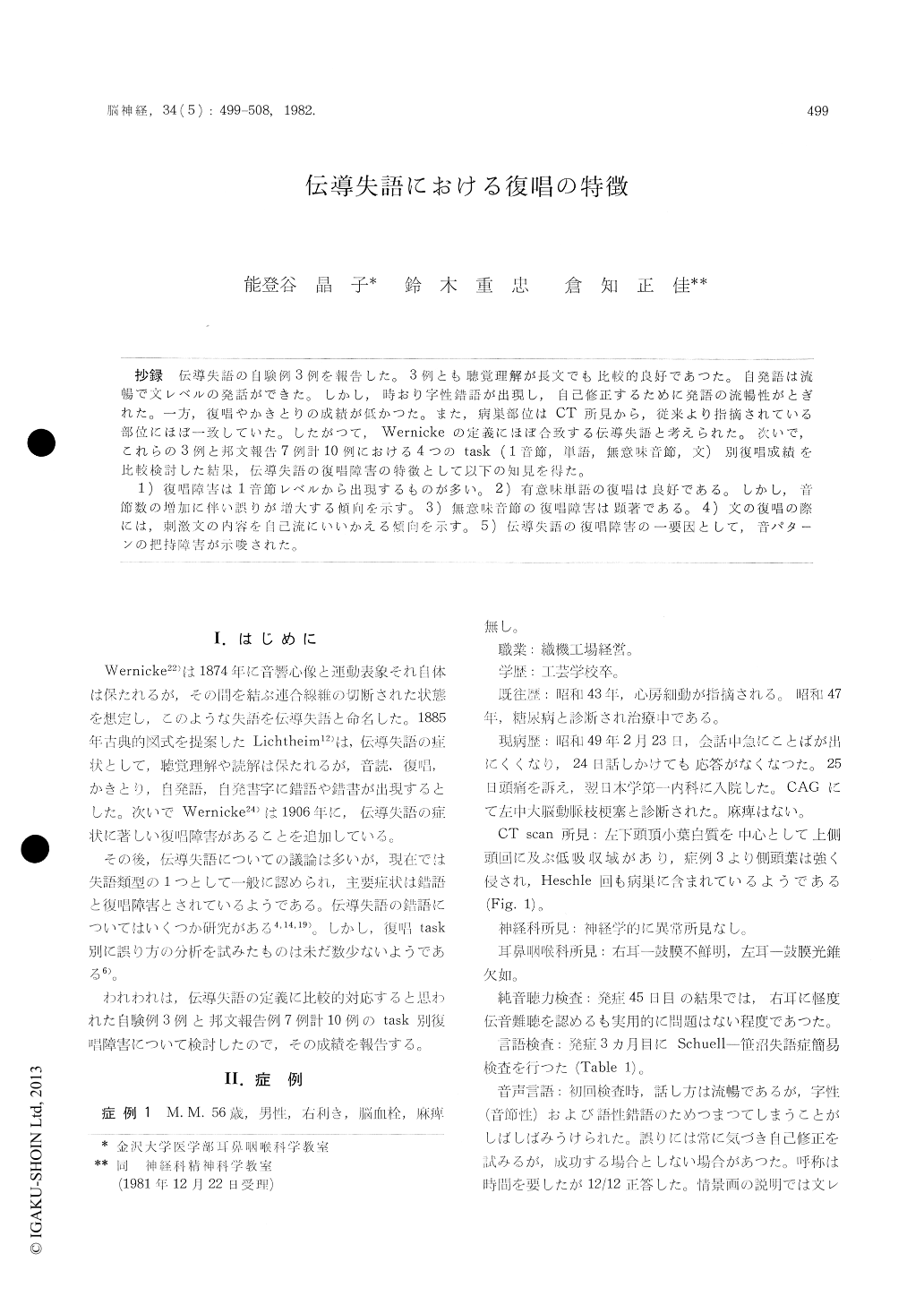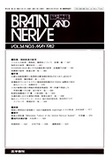Japanese
English
- 有料閲覧
- Abstract 文献概要
- 1ページ目 Look Inside
抄録 伝導失語の自験例3例を報告した。3例とも聴覚理解が長文でも比較的良好であつた。自発語は流暢で文レベルの発話ができた。 しかし,時おり字性錯語が出現し,自己修正するために発語の流暢性がとぎれた。一方,復唱やかきとりの成績が低かつた。また,病巣部位はCT所見から,従来より指摘されている部位にほぼ一致していた。したがつて,Wernickeの定義にほぼ合致する伝導失語と考えられた。次いで,これらの3例と邦文報告7例計10例における4つのtask (1音節,単語,無意味音節,文)別復唱成績を比較検討した結果,伝導失語の復唱障害の特徴として以下の知見を得た。
1)復唱障害は1音節レベルから出現するものが多い。2)有意味単語の復唱は良好である。 しかし,音節数の増加に伴い誤りが増大する傾向を示す。3)無意味音節の復唱障害は顕著である。4)文の復唱の際には,刺激文の内容を自己流にいいかえる傾向を示す。5)伝導失語の復唱障害の一要因として,音パターンの把持障害が示唆された。
Three cases of conduction aphasis were reported. Case 1 was a 56 year-old man whose symptoms were close to Wernicke's aphasis at the first exami-nation. Case 2 was a 64-year-old man who was at first considered a Broca's aphasia. Case 3 was a47-year-old man who developed conduction aphasia from the beginning. They were all right-handed men, and CT scan revealed abnormal low density area involving the cortical and subcortical portions of the lobulus parietal inferior in the left hemis-phere. After three months from the onset of the disease their clinical pictures became that of a typical conduction aphasia : Their spontaneous speech was comparatively fluent with mild para-phasia. Speech comprehension was good in the sentence level. Literal paraphasia and a disturbance of repetition were main symptoms in oral language. But the patients often tried to do self correction. Writing to dictation was as difficult as repetition.
To make clear the nature of repetition difficulties in three cases, repetition tasks consisting of one syllables, nonsense syllables, words. and sentences of various length were presented under conduction of immediate recall, and the following features were noted. 1) They sometimes faild even in one syllable task. 2) The repetition task of nonsense syllables was more difficult than that of words. 3) The longer the letter of nonsense syllables, a word and a sentence were, the more the dis-turbances appeared, of which features mainly consisted of paraphasia. 4) In the repetition of asentence, they replied in other phrase and showed errors especially in the latter half of a sentence.
Next, repetition disturbances of 10 cases, includ-ing other 7 cases who have been reported as con-duction aphasia in Japan, were analyzed. It was concluded that the characteristic features of repeti-tion disturbance in conduction aphasia were as follows ; (1) These patients often made a mistake even in the one syllabic repetition task (9/10 cases). That was inferior to the repetition of the meaning-ful words (6/7 cases). (2) The longer the letters of the words were, the more the difficulty appeared (4/4 cases). (3) The repetition score of nonsense syllables was very poor compared with that of words (9/9 cases). (4) They often replied other words instead of stimulus, especially in the latter half of sentences (5/7 cases).
These results indicat that the patients of con-duction aphasia are good at memorizing meaningful parts of words or sentence, but they have a severe difficulty in maintaining phonological patterns of them. Conduction aphasic patients may have not only articulatory programming disorders but also the disturbance in maintaining phonological patterns of speech as observed in our cases.

Copyright © 1982, Igaku-Shoin Ltd. All rights reserved.


